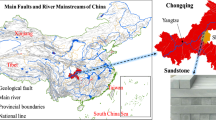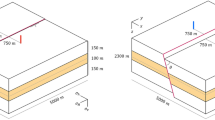Abstract
Understanding the distribution of in-situ stresses is extremely important in a wide range of fields such as oil and gas exploration and development, CO2 sequestration, borehole stability, and stress-related geohazards assessment. In the present study, the in-situ stress distribution in the Linxing area of eastern Ordos Basin, China, was analyzed based on well tested parameters. The maximum horizontal principal stress (SHmax), minimum horizontal principal stress (Shmin), and vertical stress (Sv) were calculated, and they were linearly correlated with burial depth. In general, two types of in-situ stress fields were determined in the Linxing area: (i) the in-situ stress state followed the relation Sv>SHmax>Shmin in shallow layers with burial depths of less than about 940 m, indicating a normal faulting stress regime; (ii) the SHmax magnitude increased conspicuously and was greater than the Sv magnitude in deep layers with depths more than about 940 m, and the in-situ stress state followed the relation SHmax>Sv>Shmin, demonstrating a strike-slip faulting stress regime. The horizontal differential stress (SHmax–Shmin) increased with burial depth, indicating that wellbore instability may be a potentially significant problem when drilling deep vertical wells. The lateral stress coefficient ranged from 0.73 to 1.08 with an average of 0.93 in the Linxing area. The coalbed methane (CBM) reservoir permeability was also analyzed. No obvious exponential relationship was found between coal permeability and effective in-situ stress magnitude. Coal permeability was relatively high under a larger effective in-situ stress magnitude. Multiple factors, including fracture development, contribute to the variation of CBM reservoir permeability in the Linxing area of eastern Ordos Basin.
Similar content being viewed by others
References
Altmann J B, Muller T M, Muller B I R, Tingay M R P, Heidbach O (2010). Poroelastic contribution to the reservoir stress path. Int J Rock Mech Min Sci, 47(7): 1104–1113
Anderson E M (1951). The Dynamics of Faulting and Dyke Formation with Applications to Britain (2nd ed). Edinburgh: Oliver
Bell J S (2006). in-situ stress and coal bed methane potential in Western Canada. Bull Can Pet Geol, 54(3): 197–220
Bell J S, Bachu S (2003). In situ stress magnitude and orientation estimates for Cretaceous coal-bearing strata beneath the plains area of central and southern Alberta. Bull Can Pet Geol, 51(1): 1–28
Binh N T T, Tokunaga T, Son H P, Van Binh M (2007). Present-day stress and pore pressure fields in the Cuu Long and Nam Con Son Basins, offshore Vietnam. Mar Pet Geol, 24(10): 607–615
Bredehoeft J D, Wolff R G, Keys W S, Shuter E (1976). Hydraulic fracturing to determine regional in situ stress field, Piceance Basin, Colorado. Geol Soc Am Bull, 87(2): 250–258
Brooke-Barnett S, Flottmann T, Paul P K, Busetti S, Hennings P, Reid R, Rosenbaum G (2015). Influence of basement structures on in situ stresses over the Surat Basin, southeast Queensland. J Geophys Res Solid Earth, 120(7): 4946–4965
Brown E T, Hoek E (1978). Trends in relationships between measured in situ stresses and depth. Int J Rock Mech Min Sci Geomech Abstr, 15 (4): 211–215
Bustin R M, Cui X, Chikatamarla L (2008). Impacts of volumetric strain on CO2 sequestration in coals and enhanced CH4 recovery. Am Assoc Pet Geol Bull, 92: 15–29
Chen G, Ding C, Xu L M, Zhang H R, Hu Y X, Yang F, Li N, Mao X N (2012). Analysis on the thermal history and uplift process of Zijinshan intrusive complex in the eastern Ordos Basin. Chin J Geophys, 55(11): 3731–3741 (in Chinese)
Enever J R, Yassir N, Willoughby D R, Addis M A (1996). Recent experience with extended leak-off tests for in-situ stress measurement in Australia. The APPEA Journal, 36(1): 528–535
Finkbeiner T, Zoback M, Flemings P, Stump B (2001). Stress, pore pressure, and dynamically constrained hydrocarbon columns in the South Eugene Island 330 field, northern Gulf of Mexico. Am Assoc Pet Geol Bull, 85: 1007–1031
Gentzis T (2009). Stability analysis of horizontal coalbed methane well in the Rocky Mountain Front Ranges of southeast British Columbia, Canada. Int J Coal Geol, 77(3–4): 328–337
Gu J Y, Zhang B, Guo M Q (2016). Deep coalbed methane enrichment rules and its exploration and development prospect in Linxing block. Journal of China Coal Society, 41(1): 72–79 (in Chinese)
Guo B G, Xu H, Meng S Z, Zhang W Z, Liu Y N, Luo H H, Li Y, Shen W M (2012). Geology condition analysis for unconventional gas coexploration and concurrent production in Linxing area. China Coalbed Methane, 9(4): 3–6 (in Chinese)
Hillis R R (2001). Coupled changes in pore pressure and stress in oil fields and sedimentary basins. Petrol Geosci, 7(4): 419–425
Hoek E, Brown E T (1980). Underground Excavations in Rock. London: The Institution of Mining and Metallurgy
Hubbert M K, Willis D G (1957). Mechanics of hydraulic fracturing. Petroleum Transactions, the American Institute of Mining. Metallurgical, and Petroleum Engineers, 210: 153–168
Jones S C (1972). A rapid accurate unsteady-state klinkenberg permeameter. Society of Petroleum Engineers Journal, 12(5): 383–397
Ju W, Shen J, Qin Y, Meng S Z, Wu C F, Shen Y L, Yang Z B, Li G Z, Li C (2017). in-situ stress state in the Linxing region, eastern Ordos Basin, China: implications for unconventional gas exploration and production. Mar Pet Geol, 86: 66–78
Ju W, Sun W F (2016). Tectonic fractures in the Lower Cretaceous Xiagou Formation of Qingxi Oilfield, Jiuxi Basin, NW China. Part two: numerical simulation of tectonic stress field and prediction of tectonic fractures. J Petrol Sci Eng, 146: 626–636
Ju W, Sun W F, Hou G T (2015). Insights into the tectonic fractures in the Yanchang Formation interbedded sandstone-mudstone of the Ordos Basin based on core data and geomechanical models. Acta Geol Sin, 89(6): 1986–1997
Kang H, Zhang X, Si L, Wu Y, Gao F (2010). in-situ stress measurements and stress distribution characteristics in underground coal mines in China. Eng Geol, 116(3–4): 333–345
Konstantinovskaya E, Malo M, Castillo D A (2012). Present-day stress analysis of the St. Lawrence Lowlands sedimentary basin (Canada) and implications for caprock integrity during CO2 injection operations. Tectonophysics, 518: 119–137
Li Y, Tang D Z, Xu H, Yu T X (2014). in-situ stress distribution and its implication on coalbed methane development in Liulin area, eastern Ordos Basin, China. J Petrol Sci Eng, 122: 488–496
Matthews W R, Kelly J (1967). How to predict formation pressure and fracture gradient. Oil Gas J, 65: 92–106
McKee C R, Bumb A C, Koenig R A (1988). Stress-dependent permeability and porosity of coal and other geologic formations. Society of Petroleum Engineers Journal, 3(1): 81–91
Meng Z P, Zhang J C, Wang R (2011). in-situ stress, pore pressure and stress-dependent permeability in the Southern Qinshui Basin. Int J Rock Mech Min Sci, 48(1): 122–131
Nian T, Wang G W, Xiao C W, Zhou L, Deng L, Li R J (2016). The in situ stress determination from borehole image logs in the Kuqa Depression. J Nat Gas Sci Eng, 34: 1077–1084
Paul S, Chatterjee R (2011). Determination of in situ stress direction from cleat orientation mapping for coal bed methane exploration in south-eastern part of Jharia coalfield, India. Int J Coal Geol, 87(2): 87–96
Rajabi M, Tingay M R P, Heidbach O (2016). The present-day state of tectonic stress in the Darling Basin, Australia: implications for exploration and production. Mar Pet Geol, 77: 776–790
Ritts B D, Hanson A D, Darby B J, Nanson L, Berry A (2004). Sedimentary record of Triassic intraplate extension in North China: evidence from the nonmarine NW Ordos Basin, Helan Shan and Zhuozi Shan. Tectonophysics, 386(3–4): 177–202
Seidle J P, Jeansonne M W, Erickson D J (1992). Application of matchstick geometry to stress dependent permeability in coals. In: SPE Rocky Mountain Regional Meeting. Society of Petroleum Engineers, Casper.
Sibson R (1994). Crustal stress, faulting and fluid flow. In: Parnell J, ed. Geofluids: Origin, Migration and Evolution of Fluids in Sedimentary Basins. Geological Society of London, Special Publication 78: 69–84
Somerton W H, Soylemezoglu I M, Dudley R C (1975). Effect of stress on permeability of coal. Int J Rock Mech Min Sci, 12(5–6): 129–145
Sun L Z, Kang Y S, Wang J, Jiang S Y, Zhang B, Gu J Y, Ye J P, Zhang S R (2017). Vertical transformation of in-situ stress types and its control on coalbed reservoir permeability. Geological Journal of China Universities, 23(1): 148–156 (in Chinese)
Tingay M R P, Hills R R, Morley C K, King R C, Swarbrick R E, Damit A R (2009). Present-day stress and neotectonics of Brunei: implications for petroleum exploration and production. Am Assoc Pet Geol Bull, 93(1): 75–100
Tingay M R P, Morley C K, Hillis R R, Meyer J (2010). Present-day stress orientation in Thailand’s basins. J Struct Geol, 32(2): 235–248
White A J, Traugott M O, Swarbrick R E (2002). The use of leak-off tests as means of predicting minimum in-situ stress. Petrol Geosci, 8(2): 189–193
White C M, Smith D H, Jones K L, Goodman A L, Jikich S A, La Count R B, Du Bose S B, Ozdemir E, Morsi B I, Schroeder K T (2005). Sequestration of carbon dioxide in coal with enhanced coalbed methane recovery: a review. Energy Fuels, 19(3): 659–724
Yang J J (2002). Tectonic Evolution and Oil-gas Reservoirs Distribution in Ordos Basin. Beijing: Petroleum Industry Press (in Chinese)
Yang S X, Yao R, Cui X F, Chen Q C, Huang L Z (2012). Analysis of the characteristics of measured stress in Chinese mainland and its active blocks and North-South seismic belt. Chin J Geophys, 55(12): 4207–4217 (in Chinese)
Ye J P, Shi B S, Zhang C C (1999). Coal reservoir permeability and its controlled factors in China. Journal of China Coal Society, 24(2): 118–122 (in Chinese)
Zhang J, Standifird W B, Lenamond C (2008). Casing ultradeep, ultralong salt sections in deep water: a case study for failure diagnosis and risk mitigation in record-depth well. Society of Petroleum Engineers, 114273
Zhang J, Standifird W B, Roegiers J C, Zhang Y (2007). Stressdependent permeability in fractured media: from lab experiments to engineering applications. Rock Mech Rock Eng, 40(1): 3–21
Zhao J L, Tang D Z, Xu H, Li Y, Li S, Tao S, Lin W J, Liu Z X (2016). Characteristic of in situ stress and its control on the coalbed methane reservoir permeability in the eastern margin of the Ordos Basin, China. Rock Mech Rock Eng, 49(8): 3307–3322
Zhao Q B (1997). Potential evaluation parameters and exploration direction in a coalbed gas region. Petroleum Exploration and Development, 24(1): 6–10 (in Chinese)
Zhou X J, Burbey T J (2016). The mechanism of faulting regimes change over depths in the sedimentary layers in an intracratonic basin. Arab J Geosci, 9(1): 1–11
Zoback M D (2007). Reservoir Geomechanics. Cambridge: Cambridge University Press
Zoback M D, Barton C A, Brudy M, Castillo D A, Finkbeiner T, Grollimund B R, Moos D B, Peska P, Ward C D, Wiprut D J (2003). Determination of stress orientation and magnitude in deep wells. Int J Rock Mech Min Sci, 40(7–8): 1049–1076
Acknowledgements
We would like to express our gratitude to the reviewers for offering constructive suggestions and comments which improved this manuscript in many aspects. This work was supported by the National Science and Technology Major Project (No. 2016ZX05066), the National Natural Science Foundation of China (Grant Nos. 41702130, 41672149, and 41672146), the Fundamental Research Funds for the Central Universities (2015XKZD07), and Priority Academic Program Development of Jiangsu Higher Education Institutions (PAPD).
Author information
Authors and Affiliations
Corresponding author
Rights and permissions
About this article
Cite this article
Ju, W., Shen, J., Qin, Y. et al. In-situ stress distribution and coalbed methane reservoir permeability in the Linxing area, eastern Ordos Basin, China. Front. Earth Sci. 12, 545–554 (2018). https://doi.org/10.1007/s11707-017-0676-6
Received:
Accepted:
Published:
Issue Date:
DOI: https://doi.org/10.1007/s11707-017-0676-6




